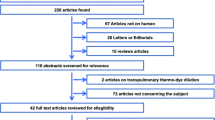Abstract
Cardiac index (CI) may be derived from the Fick method, using measured or estimated oxygen consumption (VO2), or from thermodilution. In children, LaFarge VO2 estimates correlate poorly with measured VO2 values. In a large adult cohort, there was only modest correlation between estimated Fick CI (eFick CI) and thermodilution CI (TDCI). We evaluated the extent of agreement between eFick CI using LaFarge estimates of VO2 and TDCI in a pediatric cohort. A retrospective, single-center chart review of patients 3–18 years of age who underwent cardiac catheterization with documented eFick CI and TDCI from 2004 to 2020 included 201 catheterizations from 161 unique patients. The mean patient age at catheterization was 12.2y (SD 4.4y). The most frequent diagnosis was cardiomyopathy, followed by congenital heart disease and pulmonary hypertension. TDCI and eFick CI differed by > 20% in 49% of catheterizations. eFick CI systematically exceeded TDCI by a mean percentage difference of 24% (SD 31%). Higher mean CI ((eFick CI + TDCI)/2) and older age were predictive of greater percent difference between eFick CI and TDCI. For each increase in mean CI by 1.0 L/min/m2, the expected percent difference in CI increased by 9.9% (p < 0.001). In pediatric patients undergoing cardiac catheterization, eFick CI with LaFarge VO2 systematically exceeds TDCI. The difference between methods is frequently > 20%, which may have clinically significant implications. Discrepancies between eFick CI and TDCI increase at higher mean CI.

Similar content being viewed by others
Data Availability
The datasets used and/or analyzed during the current study are available from the corresponding author on reasonable request.
Abbreviations
- CI:
-
Cardiac index
- CO:
-
Cardiac output
- eFick CI:
-
Estimated Fick method cardiac index
- NOS:
-
Not otherwise specified
- PVRI:
-
Pulmonary vascular resistance index
- TDCI:
-
Thermodilution cardiac index
- VO2 :
-
Oxygen consumption
References
Pinsky MR (2003) Why measure cardiac output? Crit Care 7(2):114–116. https://doi.org/10.1186/cc1863
LaFarge CG, Miettinen OS (1970) The estimation of oxygen consumption. Cardiovasc Res 4(1):23–30
Li J, Bush A, Schulze-Neick I, Penny DJ, Redington AN, Shekerdemian LS (2003) Measured versus estimated oxygen consumption in ventilated patients with congenital heart disease: the validity of predictive equations. Crit Care Med 31(4):1235–1240. https://doi.org/10.1097/01.CCM.0000060010.81321.45
Rutledge J et al (2010) Validity of the lafarge equation for estimation of oxygen consumption in ventilated children with congenital heart disease younger than 3 years–a revisit. Am Heart J 160(1):109–114. https://doi.org/10.1016/j.ahj.2010.04.003
Seckeler MD, Hirsch R, Beekman RH, Goldstein BH (2014) Validation of cardiac output using real-time measurement of oxygen consumption during cardiac catheterization in children under 3 years of age. Congenit Heart Dis 9(4):307–315. https://doi.org/10.1111/chd.12140
Schmitz A et al (2008) Comparison of calculated with measured oxygen consumption in children undergoing cardiac catheterization. Pediatr Cardiol 29(6):1054–1058. https://doi.org/10.1007/s00246-008-9248-6
Fakler U, Pauli C, Hennig M, Sebening W, Hess J (2005) Assumed oxygen consumption frequently results in large errors in the determination of cardiac output. J Thorac Cardiovasc Surg 130(2):272–276. https://doi.org/10.1016/j.jtcvs.2005.02.048
Seckeler MD, Hirsch R, Beekman RH 3rd, Goldstein BH (2015) A new predictive equation for oxygen consumption in children and adults with congenital and acquired heart disease. Heart 101(7):517–524. https://doi.org/10.1136/heartjnl-2014-306378
Ralston BH, Waberski AT, Kanter JP, Schick JW, Downing TE (2023) Measured oxygen consumption during pediatric cardiac catheterization is more accurate than assumed oxygen consumption. Pediatr Cardiol. https://doi.org/10.1007/s00246-023-03186-x
Maslow A, Bert A, Singh A, Sweeney J (2016) Point-of-care hemoglobin/hematocrit testing: comparison of methodology and technology. J Cardiothorac Vasc Anesth 30(2):352–362. https://doi.org/10.1053/j.jvca.2015.11.010
Argueta EE, Paniagua D (2019) Thermodilution cardiac output: a concept over 250 years in the making. Cardiol Rev 27(3):138–144. https://doi.org/10.1097/CRD.0000000000000223
van Grondelle A, Ditchey RV, Groves BM, Wagner WW Jr, Reeves JT (1983) Thermodilution method overestimates low cardiac output in humans. Am J Physiol 245(4):H690–H692. https://doi.org/10.1152/ajpheart.1983.245.4.H690
Nishikawa T, Dohi S (1993) Errors in the measurement of cardiac output by thermodilution. Can J Anaesth 40(2):142–153. https://doi.org/10.1007/BF03011312
McKenzie SC et al (2018) Reliability of thermodilution derived cardiac output with different operator characteristics. J Clin Monit Comput 32(2):227–234. https://doi.org/10.1007/s10877-017-0010-6
Opotowsky AR et al (2017) Thermodilution vs estimated Fick cardiac output measurement in clinical practice: an analysis of mortality from the veterans affairs clinical assessment, reporting, and tracking (VA CART) program and vanderbilt university. JAMA Cardiol 2(10):1090–1099. https://doi.org/10.1001/jamacardio.2017.2945
Pauli C, Fakler U, Genz T, Hennig M, Lorenz HP, Hess J (2002) Cardiac output determination in children: equivalence of the transpulmonary thermodilution method to the direct Fick principle. Intensive Care Med 28(7):947–952. https://doi.org/10.1007/s00134-002-1334-2
Manthous CA, Hall JB, Kushner R, Schmidt GA, Russo G, Wood LD (1995) The effect of mechanical ventilation on oxygen consumption in critically ill patients. Am J Respir Crit Care Med 151(1):210–214. https://doi.org/10.1164/ajrccm.151.1.7812556
Acknowledgements
We thank Eric Vu, MD for his expertise in and discussion of anesthesia practices in the cardiac catheterization laboratory.
Funding
This research did not receive any specific grant from funding agencies in the public, commercial, or not-for-profit sectors.
Author information
Authors and Affiliations
Contributions
AAL and KM formulated the study and wrote the manuscript. AAL collected the data. CL analyzed the data. AAL, PT, CM, and KM analyzed the results and reviewed the manuscript. All authors approved of the final manuscript.
Corresponding author
Ethics declarations
Conflict of interest
All authors declare that they have no competing interests.
Ethics Approval
The study was approved by the Lurie Children’s Hospital IRB. The study was HIPAA compliant and informed consent was waived.
Consent for Publication
Not applicable.
Additional information
Publisher's Note
Springer Nature remains neutral with regard to jurisdictional claims in published maps and institutional affiliations.
Rights and permissions
Springer Nature or its licensor (e.g. a society or other partner) holds exclusive rights to this article under a publishing agreement with the author(s) or other rightsholder(s); author self-archiving of the accepted manuscript version of this article is solely governed by the terms of such publishing agreement and applicable law.
About this article
Cite this article
Lawson, A.A., Tannous, P., Laternser, C. et al. The Estimated Fick Method Systematically Over-Estimates Cardiac Index Compared to Thermodilution in Children. Pediatr Cardiol (2024). https://doi.org/10.1007/s00246-024-03491-z
Received:
Accepted:
Published:
DOI: https://doi.org/10.1007/s00246-024-03491-z




